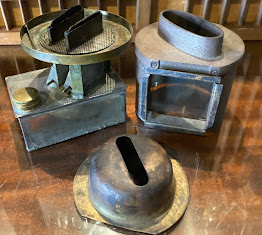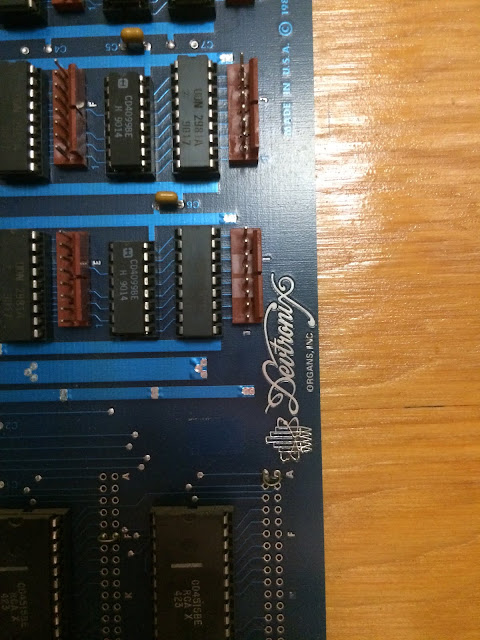If you are interested in running a Magic Lantern Show, figuring out how to illuminate your 1800's lantern can be a bit challenging. In order to understand the best method for my own shows, I tried several experiments to find the best match.
Classic Sources
To understand the problem it's worth reviewing how lanterns were illuminated in the 1800s and early 1900s.
Candles
Earliest lanterns and toy lanterns used candles. They aren't very bright so are only useful for small images in dark places. One "candlepower" is a mere 12.57 lumens.
Kerosene
Single, Double, and Triple wick kerosene lanterns were often used with magic lanterns. These produce quite a bit more light than a candle but still are rather limited. They also produce a lot of heat!
Limelight
Limelight is produced by heating a piece of calcium oxide. Although it produces a very bright light, it is dangerous, has legal restrictions, and is no longer practical for modern shows.
Carbon Arc
Carbon arc lighting is produced by creating a spark between two pieces of carbon. I remember building my first carbon arc when I was 12 years old using an arc welder and the carbon rods from D Cell batteries. There are still lanterns around with their original carbon arc lighting. Here is a carbon arc lamp at the State Theater in Oroville.
This is a loud, smokey, and complicated way to illuminate a lantern. Like the other classic lighting techniques, no longer practical for modern shows.
Mazda Bulbs
When electricity became readily available, Edison Mazda lamps were popular to covert lanterns to use the new fangled electricity. Many lanterns had their kerosene components removed and retrofitted to the new technology. These often come in 300-400 watts. Notice the compact filament and the classic "Edison Bulb" shape.
Modern Sources
Incandescent Bulbs
Like their Edison Mazda lamp predecessor, modern incandescent bulbs are available. These can run in the thousands of lumens. Though not as hot as Kerosene, they can be very hot! On the upside, if you have a lantern converted to use a Mazda bulb, you can likely just screw in a modern replacement. Your greatest challenge may be aligning the filament. Since the condenser on the lantern expects a relatively small light area, you need to make sure the filament on your modern bulb is in roughly the same place as the original.
Halogen projection bulbs
As film, slide, and movie projectors were commonplace in the 20th century there are a wide array to choose from in a multitude of voltages. The beauty of these lamps are three fold.
- Efficient - They produce less heat than the Incandescent bulbs
- Sturdy - They do not require a heat sink.
- Compact - They are a "point light" that concentrates light in a small place, similar to the original illumination sources.
LED Arrays
LED illumination is quickly becoming the "go to" lighting source for magic lanterns. However, it comes with some complications.
- Heat Sensitivity - Unlike the other lighting sources, LED's require a heat sink. This adds extra bulk and weight to your lantern and may not fit in all lanterns.
- Power Supply - Although a single LED will run on an 18650 cell at 3.7 volts, LED arrays can vary from 12-30 volts. This means adding a power supply to your configuration. Some power supplies have fans that are noisy.
- Density - To get the desired brightness, you will likely need an array of LED's. The spacing on these LED's can vary. Getting enough light in a small place can be challenging.
- Pattern - With an LED array you have several point sources. This can create light and dark areas due to the configuration of the array. These can sometimes show up as a pattern in your image.
Notice the difference in the density of the LED's between these two examples. The larger is a 35 watt garden light meant to run on 12 volts which sells for about $15. The smaller is a 50 watt "chip on board" (COB) LED meant to run at 30 volts which sells for about $10.
The CelSun Magic Lantern Lighting System
Thanks again to Mark and Beth Ayers for bringing this to my attention! The Celsun Magic Lantern Lighting System uses a 100 wat COB LED chip and a remote power supply. It has a sophisticated controller to control brightness and fade for Biunial or Triunial lanterns.

Mark and Beth noted - "We acquired a lovely biunial lantern and implemented LED lighting purchased from Celsun. "
My Tests
To better understand how these different lighting sources would play out in different lanterns, I tried several experiments.
Test Lanterns
Experiments were run with the following lanterns. Each has a Darlot F3.7 8.5 inch (216mm) Petzval lens.
The McCallister on the left has been electrified and has a regular E26 socket. There is room for either an A21 or A23 sized bulb. I found that the A23 aligned MUCH BETTER with the focusing condenser lens so much more light was available on screen.
The wood lantern is open in the back so I used a light bulb socket or I used my 12 lamp holder shown above. Since there was much more room, I could move the light bulb up and down to get the best alignment with the focusing condenser lens.
Light Measurement
Two different values were noted.- Lumens - This is total light output of the source. Essentially a measurement of raw brightens of the illumination source. These were all taken from the specifications of the device being tested. No attempt was made to validate the manufacturers claims.
- Lux - This is what was measured at the screen which was 8 feet away from the lantern. It is relative to the distance, lens, condenser, and configuration. It tells you how much light makes it to the screen relative to the other sources in my specific test lanterns.
The Test
I attached a light meter to wall and projected light directly on the meter. I measured different levels of brightness for each illumination source.




Results
My results are represented in the following table. Note that, since not all the lighting sources aligned perfectly with the condensing lens, the amount of light on the screen varied. Also note that since the McCallister has mirrored reflector in the back, it did much better with omni-directional incandescent bulbs than the wood lantern.I tried multiple types of illumination in two different lanterns. There are a few take aways worth mentioning.
Take Aways
- Go Modern - Modern illumination is MUCH brighter than kerosene.
- Alignment - It's important that your illumination be in the right location and be roughly the same size as the originally intended illumination. Bulbs that spread out the light too much will not work well.
- Beware of Heat! - Heat can damage your slides! Pay close attention to how much heat is transferring from your lighting source to your slide holder.
- Holding Out Hope For LED's! - Although I was not able to get the same brightness, consistent illumination, or reliability with LED's as Halogen bulbs, I expect I will be able to get there in time as I work on my heat sink, diffusion, and power supply issues.





























































